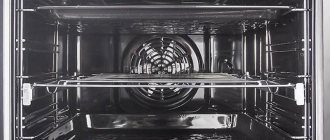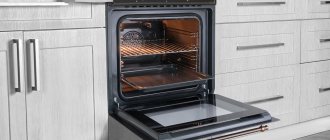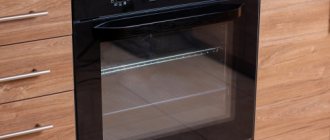Owners of a gas oven often encounter a phenomenon in which the top of the baked product remains damp, but the bottom burns. Some attribute this to the presence of a flame and the inability to clearly regulate the temperature, others to problems with the functionality of the device. In fact, the oven works fine, the basic rules for its use are simply not followed. Few housewives read the instructions for the device after purchasing it, but the specifics of handling the device are described there. You should start with the fact that it is generally better not to use baking sheets in a gas oven - they interfere with the uniform distribution of heat. The best option in this case are racks on which containers for baking workpieces are placed.
Darin's electric stove - improved with brick!
In connection with the purchase of an apartment and on the eve of the next financial crisis, we rushed to buy a relatively inexpensive kitchen stove even before the renovation. After some thought, an electric stove Darin S EM 341 404 was purchased.
When examined in the store, it aroused more confidence in us than the time-tested Dream stoves, in the new models of which there is an open gap between the glass of the ovens, into which, as the “lucky” owners say, all the fat flows in, which is simply impossible to wash off.
Electric stove Darina S EM 341 404
On the second day after the stove was delivered to us, we, having freed ourselves up a little, decided to move it away from the wall and look at the back wall of the stove. As it turns out, there isn't even a lid there. But everything is immediately visible, including shortcomings in build quality. But first things first.
1 - through hole in an electric oven; 2 - foil sticking out in shreds; 3 - brick
There is no drawer for utensils
Apparently, this is explained by the fact that this stove model is already very unstable: either the absence of this back cover had such an effect, or the oven door is outweighed, or something else, but this is not the point. As we can see in the photo above, the manufacturer was not at a loss, and to solve the problem of the stability of the electric stove, he attached a neat sand-lime brick below the oven as a counterweight.
But what really strikes the most is not the lack of a lid and the presence of bricks, which in no way affect the functionality of the stove itself. What kills the build quality is the eye-catching, carelessly cut oven insulation with scraps of foil sticking out in different directions.
Upon closer inspection, a through hole was discovered in the oven...
And if the presence of such holes in gas stoves is quite understandable, then in an electric oven what is it for? So that pies do not burn and bake evenly? Well, then why doesn’t anything burn in the same electric Dream even without a hole? Does she bake worse? Is it okay that the entire wall and the back wall of the stove itself will be “smoked” through this hole, which will be generally problematic to clean? The seller could not explain anything to us about this; we could not find such information in the instructions or on the manufacturer’s website.
Upon inspection, it turned out that the stove had no legs. As it turned out, they are also not included in the package. Although the brick is not included either. Apparently we got it as a bonus.
Features of temperature conditions
In order for a gas oven to help bring the workpiece to the desired state, and not spoil it, the temperature and time parameters must be strictly maintained. Here are just the basic recommendations, which may vary slightly depending on the characteristics of the filling and the composition of the baking dough:
- The bottom of the pizza will not burn, and its top will be covered with an appetizing crust if you bake it at a temperature of 210-220ºC for 20-25 minutes.
- For tall pies with filling, the optimal temperature is 180-200ºС. The processing time will be 35-45 minutes.
- Low pies and various buns are processed for half an hour at a temperature of 210-220ºС.
- Meringue, regardless of which oven is used, is baked at 140ºC until its top, bottom and sides are dry and covered with a dense crust.
- To bake lasagna, the temperature is set to 190-200ºС. The duration of exposure may vary. The main thing is that the top layer of the product sets and browns.
It turns out that working with the oven is not at all difficult, you just need to do everything taking into account the specifics of the device. Well, if following the nuances does not help, you should measure the temperature in the device chamber using a special thermometer. There is also a possibility that some settings were lost, or that one of the systems broke down. In this case, you should not try to figure out the problem yourself; you should immediately contact specialists who will quickly determine the cause of the phenomenon and eliminate it without risk to the device.
Root of Evil
To begin with, I decided to figure out what the problem was. Obviously, if the bottom of the baked goods is burning, then the temperature at the bottom is higher than at the top. Actually, this is a specific feature of gas ovens, in which the burner is always located at the bottom. Ideally, the heat should envelop the baked goods from all sides.
If the bottom of the baked goods burns, the heat is not distributed evenly.
What could contribute to this? I came up with several ideas:
- Temperature too high.
- The pie is too close to the flame.
- 3. Thin walls of dishes.
- The door does not close tightly, preventing heat circulation.
Let's look at the reasons
Burnt bottom of baked goods
Here are the main reasons why the bottom burns in a gas oven:
- A gas oven has its own peculiarity: proper circulation of hot air is important so that the top of the pie is golden brown and the bottom is not burnt. Therefore, empty molds and pans inside the oven can cause baked goods to burn.
- An unsuitable baking tray for a gas oven can also cause spoiled baked goods. For example, if the baking sheet is too large, then the gaps necessary for air circulation will simply not remain, which means that the heat supply will again be disrupted and the baked goods will burn.
- High temperatures are also a common cause of burning. If the housewife bakes a pie at maximum temperature in the hope that the future culinary masterpiece will simply turn brown, you can expect trouble. In this situation, the product will not only not brown, but will also burn from below, without having time to bake until fully cooked.
- If you open the door frequently while baking, the cake will not turn out well either. Such actions prevent the maintenance of normal and optimal temperatures for cooking. It's better not to do this. In addition to burning, the dough may simply fall off, and the top of the pie will not brown.
What to do to prevent the bottom of the dish from burning when baking
Water under the dish prevents burning
There are several common ways to solve this problem yourself without inviting a specialist and repairing the gas stove oven. Can:
Purchase and install a special stone that promotes uniform baking. The porous structure and increased heat capacity of this cameo allows it to warm up evenly and act as a thermal buffer in a gas oven. Most often, the material for such a stone is fireclay clay, which was previously used for stove masonry.
Baking stone
At the bottom of the oven, on the lowest level, you can place a baking tray with coarse rock salt. As a rule, one and a half kilograms is enough. This solution will eliminate excess heat, because salt absorbs it perfectly. In this case, the salt can last for several years without spoiling, and the baked goods will turn out evenly baked and with a golden crust. Ordinary sand can be an analogue of salt.
As mentioned above, you can place a dish or baking tray with water under the baking. However, in this case it is worth keeping in mind that during the cooking process the water evaporates. Therefore, sometimes it becomes necessary to add water to maintain the effect. In this regard, it is best to use this method when working with instant baked goods.
The described methods will help you independently solve the problem of burning the bottom of baked goods in a gas oven.
Also useful for repairs:
- DIY butterflies on a dress
- DIY corrugated paper bouquets step by step
- Interkerama bathroom tiles
Secrets from experienced housewives
When even following the above rules does not help, and the product still burns, you have to use techniques tested by experienced chefs. At home you can do the following:
- The pies will stop burning if you place a fireproof brick at the very bottom of the chamber. Just first you need to clean it, wash it if necessary and dry it.
Tip: The tops of savory products will set and bake in the oven a little faster if you brush them with beaten egg yolk before cooking. And sweet preparations are treated with sweetened and strongly brewed black tea for the same purpose.
- When there is no brick or you don’t want to use it for aesthetic reasons, you can take coarse salt. It is placed in a bowl made of heat-resistant material and placed under the baking rack.
- They also sometimes place a container of water in a gas oven. The liquid evaporates, raising the temperature slightly. But the products do not burn, but are evenly baked. If you want a golden brown crust to appear on your culinary masterpiece, water should be used only in the first half of baking. A dish prepared in this way also turns out juicier than usual.
Despite the simplicity of the methods, they have proven their effectiveness. If such approaches do not give the desired result, and the top and bottom continue to bake unevenly, this indicates violations of the rules for the production of semi-finished products.
Is it possible to fix ready-made pies?
You can add a blush to the pies after baking. To do this, the pies are greased with butter and covered with a towel for a while.
See also: What to grease pies / pies / buns for blush: 7 options from bakers
Sweet pies can be browned by covering them with honey, sugar or fruit syrup.
To grease the pies better and more conveniently, use a silicone brush. With its help, the brush will lie evenly on the dough.
Faulty oven switch
If the switch is faulty and turns, this also causes poor heating of the oven, since it simply does not receive the correct command to heat. Most often a complete replacement is required. To do this, the stove is disconnected from the network and the plastic handles are removed. The screws are unscrewed and the panel behind which the switches are located is removed. Next, another fastener is unscrewed on the switch mounting plate.
Connecting electric stoves to the network, monitoring and maintenance
A faulty oven switch has screws that come out. There you will see the wiring, you need to remember their location. Then the tips are removed from the wires and a working element is installed.











